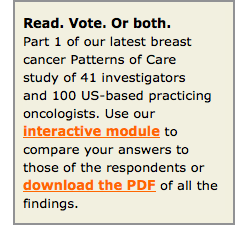

Patterns of Care in Breast Cancer — Interactive Edition: Adjuvant chemotherapy for ER-positive, HER2-negative tumors

Over the course of more than a decade I have had the pleasure of interviewing Indiana University breast cancer clinical investigator Dr Kathy Miller more times than I can even remember. A truly enlightened communicator, Dr Miller always speaks candidly and passionately about her work, and for that reason I decided to start our most recent conversation a bit differently by delving into something that has been on my mind — namely, what types of cases she (and other investigators) see as second opinions and what is the most common situation in which her view is significantly different from that of the other oncologist(s).
Kathy — who sees several second opinion cases a week in clinic and responds to many more by email and phone — did not hesitate in answering, “It comes up a lot in the use of adjuvant chemotherapy, particularly in patients with ER-positive, HER2-negative, node-negative tumors over 2 centimeters or patients with limited nodal involvement.”
She then went on to describe a recent case in which an IU colleague ordered an Oncotype DX® for a 43-year-old woman with 1 positive node referred by her surgeon, who was surprised when an initial consulting oncologist did not order the assay. On the day before the patient was scheduled to start adjuvant chemo with the first oncologist, the Recurrence Score® (RS) came back as 6 (low), leading the IU team to recommend endocrine therapy alone. The patient embraced the concept and cancelled the chemo appointment, creating some uncomfortable feelings among the parties involved.
This got me thinking about our post-SABCS Think Tank last month, during which Dr Miller, in voicing her “biology over anatomy” perspective, drew considerable objection from Dr Dan Hayes, who had recently published a JCO editorial concluding that the use of Oncotype in a patient with a node-positive tumor should be reserved for participants in the ongoing RxPONDER trial evaluating endocrine treatment alone or preceded by chemo in patients with 1 to 3 positive nodes and low RS.
Providing a window into these types of controversies is essential to our group’s CME mission, and an important tool in this regard has been our national Patterns of Care surveys of investigators and practicing oncologists. This email (the first of 3) marks the introduction of our latest breast cancer survey that is presented this time not in hard copy as in prior adventures but as an interactive web-based practicum. We begin with the core of the Miller/Hayes controversy — adjuvant chemo in ER-positive, HER2-negative tumors — and, for those of you who don’t have time to pore through all the related questions/results (they are very interesting) or aren’t inclined to try out our new format and vote, below is the “10,000-foot view” of how the use of Oncotype impacts decision-making in clinics across the country.
1. Node-negative tumors
We observed long ago that size and age matter in these treatment recommendations, and considerable heterogeneity exists at the ends of the spectra. For a 60-year-old woman with a 1- to 2-cm tumor, more than 80% of physicians order an Oncotype, but with a 0.8-cm tumor the numbers drop down and just more than half employ the test. One curious “town/gown” variation: 76% of physicians in practice use chemo if such a patient has an intermediate RS compared to only 26% of researchers.
The story is a bit different with a 3-cm tumor, for which 90% of investigators use Oncotype compared to 68% of community oncologists. Here, the nonusers are likely already committed to chemo, but 34% would hold off if someone else ordered the assay and it came back low.
2. Node-positive tumors
Physicians are about equally split between the Miller and Hayes viewpoints, with 54% of investigators ordering Oncotype in a 60-year-old woman with a 1.8-cm tumor and 1 positive node. Again, for those who would not themselves order the assay, if someone else ordered it and the RS came back low, about a third would opt out of chemotherapy.
3. Is 75 the new 60?
There has been agreement since Dr Soon Paik first presented the NSABP Oncotype data more than 10 years ago that these assays should be used only when both the physician and patient are “on the fence” about chemo, and in older people this often happens because of 2 relevant issues — the likelihood of greater toxicity and the attenuation of long-term benefit because of competing causes of mortality. For this survey we tested age 75 versus 60 in a variety of scenarios, and although there is less use of Oncotype in older individuals, the difference seems relatively modest, suggesting that at least obtaining the information for the patient and physician to consider is often on the table.
Next, for Part 2 of this interactive Patterns of Care activity/report, we present data on another rapidly evolving corner of breast oncology — patients with early and advanced HER2-positive disease.
Neil Love, MD
Research To Practice
Miami, Florida